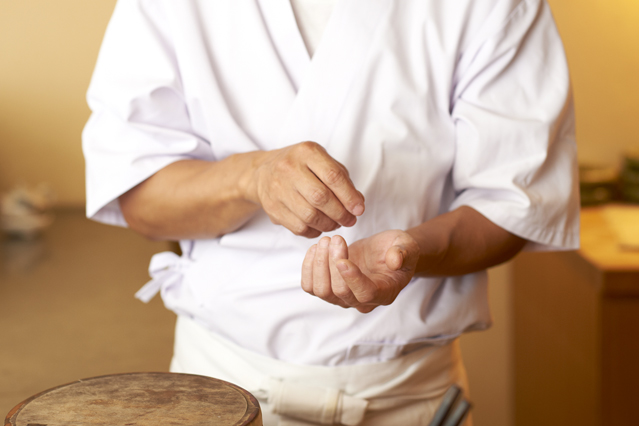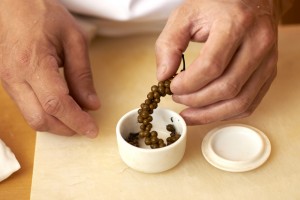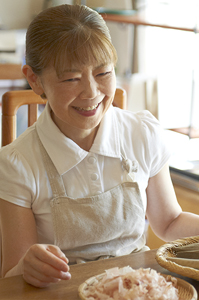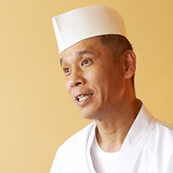Enjoy Your Sushi Bar Experience: Tips for Savvy Dining and Flavorful Choices
Dec 04,2015
Enjoy Your Sushi Bar Experience: Tips for Savvy Dining and Flavorful Choices
Dec 04,2015

Though many people say they love sushi and it’s their favorite, just as many say they feel daunted at the thought of sitting at a sushi counter and suspect there must be a byzantine etiquette to follow. For this article, to find out what you need to know to enjoy sushi at a sushi bar, we spoke with food researcher Kubo Kanako and Kubo’s old acquaintance, Yanagihara Masahiko, owner of Sushikoma in Tokyo’s Meguro ward.

— For those who do not frequent sushi bars regularly, entering a new establishment can be a nerve-wracking experience. Kubo, what do you pay attention to or strive to do when you enter an unknown sushi bar for the first time?
Kubo:When you enter a shop for the very first time, you don’t know its philosophy or what kinds of sushi it serves. That’s why I always start by asking for the omakase — leaving the choices up to the sushi chef.
Sushi bars, although often all lumped into the same category, can have very different approaches and practices. Some are very flexible in taking customer requests, whereas many others only offer omakase, though they may ask about your allergies or dislikes. Neither approach is better or worse: They are simply that shop’s philosophy, so to speak. Depending on the place, you can have fun choosing the neta [toppings] you like or you can enjoy thoroughly savoring the chef’s particular philosophy and deciphering the chef’s ideas as you eat. I like to enjoy the variety of experiences you can have.
For example, here at Sushikoma, you are open to taking requests from customers, right?
Yanagihara:Yes, we are. We have omakase, but our customers have a lot of freedom. I think we are a type of sushi bar that leaves the choices up to the customer.
Kubo:You can inquire and find out what approach the shop has. With horse mackerel, for example, some places serve it as is, others lightly cure it in vinegar, and others serve it with chopped spring onions, ginger, and coated with nikiri soy sauce. I like conger eel, but if I know that a shop serves it both salted and coated in a sauce, I may want to try the salted one first and then the coated one. That’s why I start with the omakase to see what kind of sushi they serve. Another thing I recommend people do is see how other customers place their orders and what the general atmosphere is like.

—What if you order the omakase and you get too much? Or what if there isn’t enough? In general, how many pieces of sushi do you get when you order omakase?
Yanagihara:In our shop, it’s ordinarily ten pieces. Along with a makimono roll.
Kubo:In the past, most places provided eight pieces.
Yanagihara:That’s true. In general, the portions are smaller now than in the past, so to compensate, shops have increased the number of pieces. Also, at lunchtime, the nigiri-zushi [hand-pressed sushi] are on the larger side, but at night, they are smaller.
—And if you think finishing ten pieces is too much for you today …
Kubo:Then just simply say: “I’d like to have seven or eight pieces of the omakase.” However, you need to determine whether the shop is willing to accommodate such a request. Since this is a primer, I recommend that you visit a sushi bar on an empty stomach and first ask for the omakase. After that, once you get to know a bit about the place and the staff, you can enjoy the second step, such adjusting the number of pieces or adding your favorites.
—What do you see in a sushi bar that makes you want to go back again and again?
Kubo:The first answer is obviously that I like the shop’s sushi. That the sushi is delicious is a given, but beyond that, look for the type of sushi you like, such as the thickness of the neta, how the sushi are formed, the size of the pieces, and so on. Another thing unique to sushi bars are the counter seats. You have the chefs behind the counter and then yourself and the customers around you in front of the counter. This arrangement is conducive to a natural sense of unity forming among everyone. This means that the type of customers who come to the shop and the nature of the relationship between customers and the chefs may be factors in choosing a sushi bar that you want to visit over and over again.

—When you are at a shop you’ve visited a few times and you want to order your favorites, what sequence do you order them in?
Kubo:That’s a good question. I usually start my order with white-meat fish, shellfish, and blue-backed fish with a mild flavor, followed by tuna, egg, conger eel, and other cooked items. Many people tend to order items with lighter flavors first and then move gradually toward richer tastes. Still, there are people who, for example, after having conger eel ask for white-meat fish again, and people who love tuna may order three types of tuna — red-meat tuna, medium fatty tuna, and fatty tuna — all at once. So, you shouldn’t worry too much. It’s fine to order what you feel like having at that moment.
Yanagihara:That’s right. If you are a bit anxious, start by ordering five or six pieces of omakase sushi. After that, depending on how your stomach is feeling, you can order something a bit lighter or a bit richer. Add a few of your favorite pieces to match your palate. I think this is a good way to go about it.

Kubo tends to eat sushi with her hand to avoid damaging the fish. However, for conger eel or other sushi coated with sauce, she uses chopsticks to avoid getting her hands messy.
Kubo:Since your a la carte items and starters are delicious, do many people order these?
Yanagihara:Yes, many customers order starters or sashimi before having sushi. For example, a customer may have white-meat fish or shellfish as sashimi and then order the omakase, which would mean they would repeat from white-meat fish again. When this happens at our shop, we may start the omakase right away with tuna. But the approach taken in these cases varies from shop to shop. In a way, the approach reflects the sensibilities of the shop.
Kubo:It’s true. You can see a sushi bar’s attitude and philosophy in the composition of its omakase.

Kubo:The number of sushi bars that primarily offer omakase courses have really increased in recent years.
Yanagihara:It’s been a trend for some 30 years. I feel it’s fully established itself these last 15 years or so.
Kubo:Before then, there weren’t as many omakase-centric places as today.
Yanagihara:I think the reason lies in the history sushi has followed.
Sushi originally began as nare-zushi [sushi fermented in brine]. Funa-zushi [fermented crucian carp sushi] is a famous example. Nare-zushi was a way to preserve fish. Going even further back, fish were preserved in salt. Then people realized that you could preserve fish for years by fermenting it in salt, draining the water, and drying it.
Kubo:The same idea applies to shiokara [pickled fish innards] and dried fish in Japan and beef jerky in the West.
Yanagihara:That’s right. Later on, people in Japan and other Asian countries started pickling fish in grain crops. For example, pickling fish in rice causes fermentation, which produces lactic acid bacteria. They realized that this process could preserve the fish and make it easier to eat. This is where nare-zushi got its start. That was around the Nara period (710 to 794). As fermenting technology advanced and vinegar became available, bo-zushi and hako-zushi [block-shaped pressed sushi and box-shaped pressed sushi] emerged.
Kubo:Unlike funa-zushi and other types of nare-zushi, this type of sushi let people eat fish and rice together. This led to saba-zushi [pressed mackerel sushi], battera-zushi [pressed mackerel sushi with kelp], and kakinoha-zushi, which was wrapped in a persimmon leaf and preserved.
Yanagihara:Yes, and after this came haya-zushi [quick sushi] in the Edo period (1603 to 1868), which is the present-day Edomae-zushi style, which is made with vinegared rice and neta. But back then, sushi was formed like a rice ball. They were large and round.
Kubo:Apparently those large, round sushi were eaten at food stalls like fast food today.
Yanagihara:That’s true. And it became commonplace throughout the country.
After World War II and the rapid economic growth that followed, large establishments began to pop up with long counters and many chefs lined up behind them. From there, many of the chefs went independent, opening up numerous small shops run by only a few people. As all kinds of chefs ran these sushi bars, they refined and perfected their unique skills, explored how to set their shop apart, and began to show off their individual talents.
Kubo:From there, the presentations in each shop — how they wanted the customers to eat — became more and more diverse.

Yanagihara:So, the omakase style is a new culture of haya-zushi that arose from this historical trend. One aspect of omakase is the shop wanting customers to eat sushi in a certain order and in a certain manner, presenting the sushi like a set course meal or kaiseki cuisine. The other side to its development is shops with only a few chefs devising ways to serve and satisfy large numbers of customers.
Kubo:I see. There’s an operational side to it. It’s easier, ultimately, to serve customers truly delicious sushi through omakase than having customers order whatever they like separately.
Yanagihara:Exactly. The last 30 years have probably seen more evolution in sushi than at any other time in its entire history.
—How is sushi changing today? What are some recent trends?
Kubo:First off, in tandem with omakase becoming mainstream, so too has serving sushi precoated in nikiri sauce, instead of customers dipping the sushi in soy sauce themselves.
Yanagihara:Nikiri is really soy sauce for sushi. By heating soy sauce and boiling it down, the sauce becomes ever-so-slightly thicker. As a result, it sticks better to the ingredients, and this allows us to adjust the amount of soy sauce that is best for each ingredient. Some neta should be served with just a quick coat of nikiri, while others taste better with two or three coats. So, the real advantage of nikiri is being able to adjust the amount of soy sauce to suit the neta.
Kubo:Now I get it.

Yanagihara:To my way of thinking, the real test of good sushi is the shari [vinegared rice] and the nikiri. People tend to rate sushi on the freshness of the neta, but you can’t make tasty sushi if you neglect the shari. Also vital is the balance between the shari and neta.
Kubo:That’s so true. It’s not good sushi if the taste of just the shari or just the neta remains in your mouth. Another significant difference, I feel, from shop to shop is how hard they press the sushi as they make it.
Yanagihara:That’s certainly the case. Some shops press their sushi fairly hard, while others press quite gently. This, again, is part of the individuality of the shop. In my case, I adjust how hard I press the shari depending on the neta.
Kubo:Oh, I didn’t realize that.
Yanagihara:For example, I’ll mold the shari with a little more force for fresh, firm marbled flounder than ordinary marbled flounder. This ensures a good balance between the shari and the neta. This feel is something that comes with experience. After a while, you find yourself making these adjustments naturally without thinking about them.
Kubo:That makes sense.
If we are talking about trends, sushi served with salt suddenly spiked in popularity a while ago.
Yanagihara:I noticed that too. Salt was a huge fad at first, and now it’s become a standard item.
Kubo:Another trend is to go back to the origins of sushi in the Edo period, using red vinegar and other slightly more acidic vinegars. Other shops have generated a buzz for using fermented fish.
Yanagihara:Yes, sushi has its trends. Personally, I’ve recently gotten into raw salted pepper as a condiment.

Kubo:Salted pepper?
Yanagihara:I found out it is an ingredient in Italian cuisine. The flavor of this pepper, which comes on fast and then disappears abruptly, is ideal for Japanese halfbreak caught in the spring or gizzard shad.
Kubo:It really is delicious. There’s so many creative ways to make sushi.
Yanagihara:The typical sushi condiments are wasabi, ginger, spring onions, and yuzu citrus, but there’s still lots of room for experimentation. And, of course, the flavor changes depending on where you place the condiments on the neta.
Kubo:You mean whether you put the condiments on top or sandwich them under the neta?
Yanagihara:Yes. For example, if you put yuzu on top of the neta, the yuzu’s aroma will spread out first, followed by the neta’s umami. But if you put the yuzu in the middle, you can devise it to have the yuzu fragrance bloom after the neta.
Kubo:That’s incredible that you make sushi thinking about how the flavors will react in the diner’s mouth. Knowing more about the ingenuity and creativity of sushi chefs will certainly give more depth to your enjoyment of sushi.


Culinary Researcher
Culinary Researcher
Growing increasingly interested in cooking, Kubo Kanako studied at the long-established Kyoto ryotei (high-class Japanese restaurant) Tankuma Kitamise from the time she was a high school student. After graduating from the Department of English at Doshisha University, she entered the Tsuji Culinary Institute, where she obtained chef’s and fugu (puffer fish) cooking licenses. Following a stint in the Tsuji Culinary Institute’s publications arm, she edited cook books at a publishing house in Tokyo, before going independent.
Today, Kubo is actively involved in a variety of culinary-related endeavors, including culinary production, styling, restaurant menu development, table decorating, editing and more.
She is the author of several works in Japanese, including Utsukushii morituske no kihon [Basics of Beautiful Plating] (Seibido Shuppan), Utsukushii ichiju nisai: “Oishii” to “kirei” in ha wake ga aru [Beautiful Soup and Two Dishes: There are Reasons for “Deliciousness” and “Beauty”] (Kawade Shobo Shinsha), Kichinto, yasai no kobachi chotto shita kotsu de “mō ippin” ga gutto oishikunaru! [Small Vegetable Side Dishes: Little Tips that Make That Extra Something So Much More Delicious] (Kawade Shobo Shinsha), Kichinto, oishii mukashinagara no ryōri [Delicious Old-Time Cooking] and Shun no aji techō aki to fuyu [Seasonal Flavor Handbook: Fall and Winter] (both Seibido Shuppan)

Yanagihara was born in Hokkaido in 1965. After training for nine years in Hokkaido, he met Nozaki Hiromitsu at Waketokuyama and was picked from many candidates to be the head chef at Sushicho, a sister shop of Waketokuyama, when it was launched. In 2006, he opened Sushikoma near Toritsu-Daigaku Station.
Sushikoma
1F Hermitage Yakumo, 1-8-9 Yakumo, Meguro-ku, Tokyo
TEL:03-5731-0035
Business hours : 11:30 a.m. to 1:30 p.m. (last order), 5:30 p.m. to 10:30 p.m. (last order)
Closed:Mondays